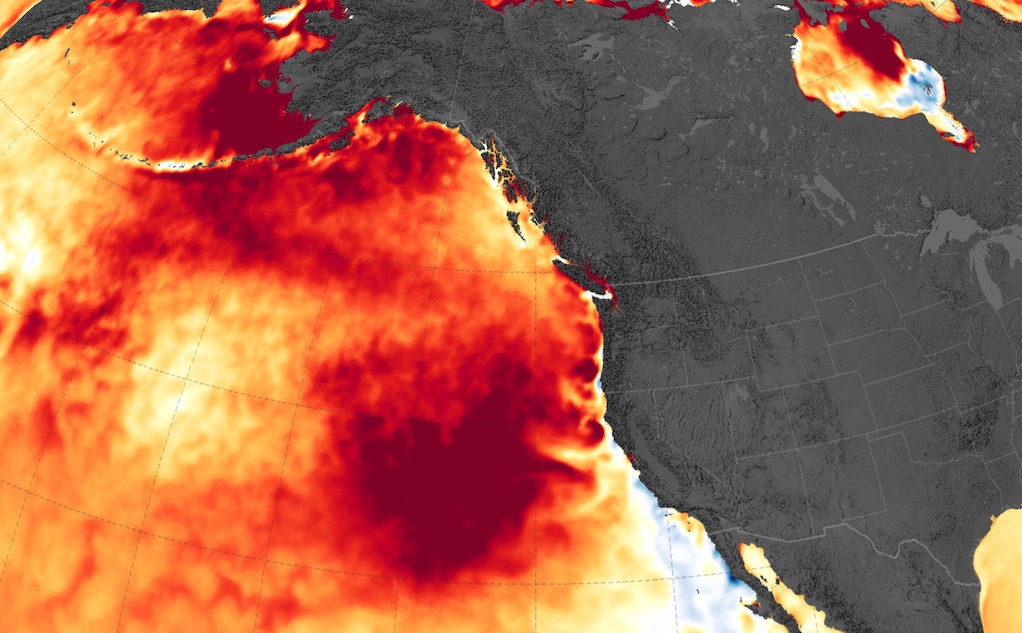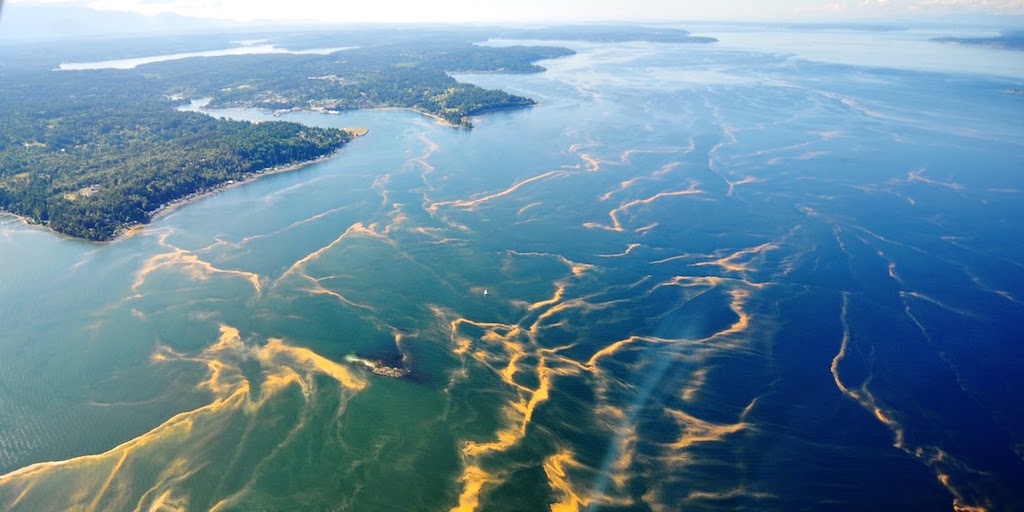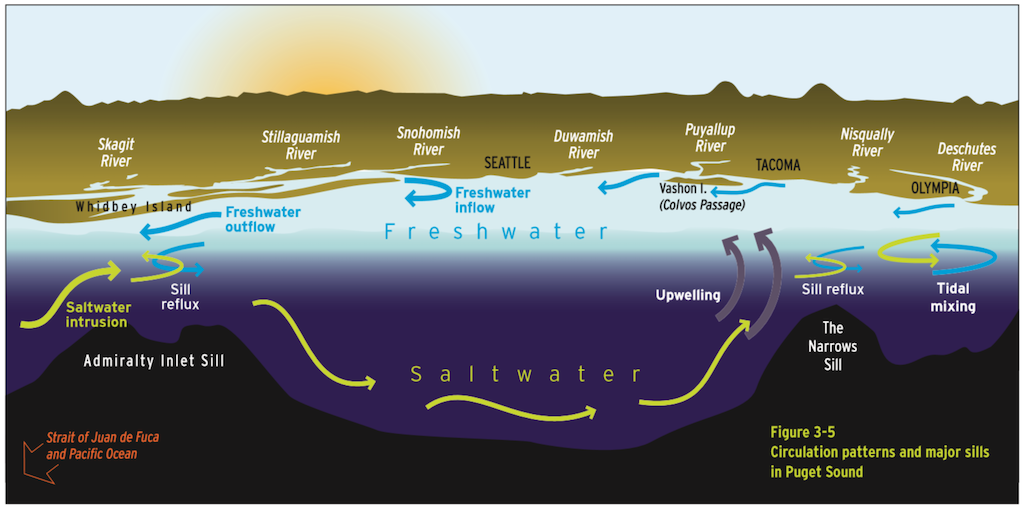This is further complicated by the Salish Sea’s varied and uneven seafloor. When glaciers retreated from what is now called Puget Sound thousands of years ago, they left behind elevated portions of the seafloor called sills. There is a sill at Hood Canal on the Olympic Peninsula, and a similar restriction at The Narrows by Tacoma. Admiralty Inlet has a double sill. Sills are places of turbulence: Deep water is forced up and over them, so when the fresher surface layer is moving one way and the deeper layer of oceanic water is moving the other, the deep water can rise and mix with the surface layer and get redirected. This is called reflux.
“All of this means that when seawater affected by the blob came in through Puget Sound during the first marine heat wave, some of it was retained through reflux,” Newton says. “And because the Salish Sea is shallower than the ocean on the outer coast, and we had some warmer-than-average air temperatures and ended up with some significant local heating that lasted in some cases years longer than the immediate effects of the blob on the outer coast.”
Scientists in British Columbia noticed that trend in fjords as well, where several inlets with similar seafloor features have been monitored for decades. “For these inland waters, the impact of the marine heat wave was really clear in the deep-water column,” says Jennifer Jackson, an oceanographer with the Hakai Institute. “Heat lingered from early 2015 basically up until now, and the deep water is still anomalously warm.” The sills that fronted the inlets prevented cooler ocean water from entering, effectively trapping hotter water from the blob.
When Jackson published these findings in 2018, it was one of the first papers about the effects of marine heat waves on inland waters. “Marine heat waves themselves are still a pretty new concept,” she says. “Most of what we know about them is based on the open ocean, and then on surface data or satellite data, because it’s easier to get broad coverage. But now we’re starting to learn what happens below the surface.”
Not just temperature
Additional research now coming out of the blob years has also shown that while sea temperatures may be a useful proxy for a marine heat wave’s presence, they are not the only aspect of ocean conditions affected.
Simone Alin, an oceanographer at NOAA’s Pacific Marine Environmental Laboratory in Seattle, has for more than a decade been part of a team with the Washington Ocean Acidification Center that tracked conditions in Puget Sound on research cruises in the spring, summer, and fall. Alin found that, while water column temperatures had cooled somewhat from peak-blob conditions by July 2017, they were still considerably higher than before the blob. But that was not all: Anomalies in water chemistry in the southern Salish Sea could be decoupled from the warming itself.
“When 2015 rolled around and we knew we were being hammered with a lot of heat, we were worried that since warmer water suggests you’re going to have higher rates of biological processes, it would lead to terrible conditions for oxygen and ocean acidification,” Alin says. But that wasn’t necessarily what she found. In certain places, like in southern Hood Canal, things were surprisingly better than oceanographers expected. “Areas where we saw very low oxygen and corrosive conditions in July 2015 were flushed out earlier by marine intrusions,” Alin says, “so that by the time September rolled around and you might brace yourself for fish kills, the water was actually in much better shape.”
But the flip side was also true. On a cruise in the fall of 2017, both in Puget Sound and outwards through the Strait of Juan de Fuca, researchers documented significantly elevated levels of acidification. “It wasn’t a heat signal that we were seeing compared to years previous, but still we observed very high CO2, low pH levels, and low aragonite saturation in places where we don’t normally see such harmful conditions.” At first Alin thought something was wrong with the samples, but then her team saw same thing in a second cruise around the same time. “We’re still seeing a lot of anomalies, and it’s complicated to work out how they’re related to each other, or driven by other factors,” she says. “I’ve been beating my head against a huge dataset for a few years, trying to figure out what stories I can tell because it’s so complicated.” All of this comes as oceanographers detected another patch of warm water in the summer of 2019 off the west coast of the U.S. and Canada. It was smaller than the blob, but not by much, and it was just as warm. At the University of Washington, Jan Newton worried that it was going to slam the region still recovering from the effects of the blob. But then the patch disappeared, or seemed to, before reappearing last April.
“I don’t know if it’s technically declared a marine heat wave yet,” Newton says. “But the larger question is, is this a new normal starting to develop?” Of that she is not sure. But if it is, like so many others, she worries that the unprecedented ecological disruptions seen just a few years ago will become drearily precedented.




